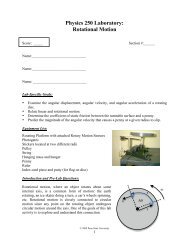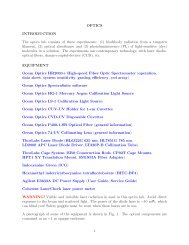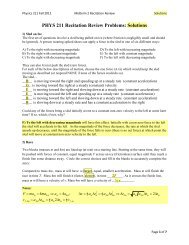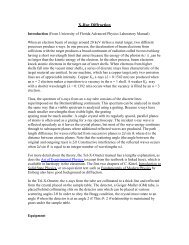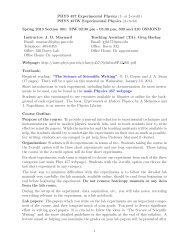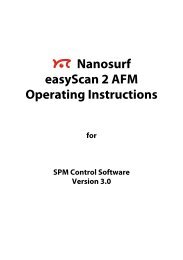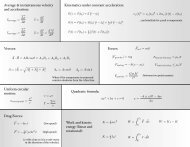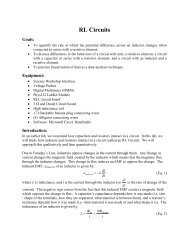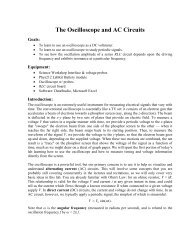Playing Physics Jeopardy
Playing Physics Jeopardy
Playing Physics Jeopardy
You also want an ePaper? Increase the reach of your titles
YUMPU automatically turns print PDFs into web optimized ePapers that Google loves.
volume must be 1.7810 3 m 3 or greater. The student must<br />
also think about units and conversions because the volume is<br />
given in the equation in m 3 , but the question asks for the<br />
volume in liters.<br />
Consider a <strong>Jeopardy</strong> Problem involving the component<br />
form of Newton’s second law applied to an object on an<br />
incline,<br />
Fig. 1. The equation N(60 kg)(9.8 m/s 2 )0 describes the situations<br />
shown in a and b.<br />
appropriate—an opportunity to confront a common student<br />
alternative belief.<br />
The first example is quite simple. More challenging <strong>Jeopardy</strong><br />
Problems can be created with relative ease. Take a standard<br />
problem and use a basic principle to write an equation<br />
that describes the problem process. Consider the following<br />
examples that represent either the description of a process at<br />
one instant of time or a continuous process with a beginning<br />
and an end the initial and final states of the process. An<br />
example of the latter is shown below with the left side of the<br />
equation representing the initial state and the right side the<br />
final state,<br />
1/26000 N/m2.00 m 2 72 kg9.8 m/s 2 17 m.<br />
The 1/2 times a number with units N/m times the square of a<br />
distance causes an experienced physicist to think of the elastic<br />
potential energy of a stretched or compressed spring. On<br />
the right side of the equation we have gravitational potential<br />
energy with a mass, the acceleration due to gravity and a<br />
distance height. If the left side is the initial energy and the<br />
right side the final energy, the process might involve an ejector<br />
seat with a compressed spring launching a 72-kg object<br />
another person upward a maximum distance of 17 m. There<br />
could of course be other processes described by the equation,<br />
such as a compressed spring launching the object up a frictionless<br />
incline so that the total change in elevation is 17 m.<br />
Students are encouraged to think divergently when inventing<br />
processes described by the equations.<br />
A <strong>Jeopardy</strong> Problem representing a steady state process is<br />
shown below:<br />
12 VI1/5 6 1/8 1 14 .<br />
The task here is to draw an electric circuit. Once again the<br />
student must translate a mathematical relation into a reasonable<br />
physical situation—in this case a diagram rather than a<br />
verbal statement.<br />
Consider a <strong>Jeopardy</strong> Problem that is followed by a series<br />
of questions to help students develop better conceptual understanding,<br />
1.39 kg9.8 m/s 2 <br />
780 kg/m 3 9.8 m/s 2 1.7810 3 m 3 0.<br />
After students decide that the equation describes an object<br />
floating in some liquid, which is not water, we might ask<br />
additional questions. What is the liquid? What is the volume<br />
of the floating object in liters? This latter question requires<br />
the student to realize that the 1.7810 3 m 3 in the right<br />
term of the equation is a lower limit for the volume of the<br />
object. The object would be in neutral buoyancy if immersed<br />
to its full volume and still ‘‘floating.’’ Since the 1.78<br />
10 3 m 3 is the lower limit for the object’s volume, the<br />
150 N14.5 kg9.8 m/s 2 sin 34°0.3214.5 kg<br />
9.8 m/s 2 cos 34°14.5 kga x .<br />
With a little work, a physicist will recognize that something<br />
exerts a 150-N force parallel to a 34° incline while pulling<br />
or pushing a 14.5-kg object up the incline. There is friction<br />
with a 0.32 kinetic friction coefficient between the object and<br />
the inclined surface. This <strong>Jeopardy</strong> Problem is somewhat<br />
more challenging. We can ask the students to translate from<br />
the mathematical representation to a physics sketch, a freebody<br />
diagram in this case, and then from the diagram to a<br />
picture-like sketch of an appropriate physical situation. Finally,<br />
students could be asked to invent a word problem that<br />
is consistent with the equation.<br />
<strong>Jeopardy</strong> Problems can be constructed for all physics subjects.<br />
For example, students might be given an application of<br />
the first law of thermodynamics (QUW) for an ideal<br />
gas, where W is the work done by the system:<br />
Q8.0 mol8.31 J/mol K361 Kln34.3 L/60 L.<br />
The students would either be asked to describe a physical<br />
process for which the equation applies or to answer a variety<br />
of questions such as the following. What type of process is<br />
this? How do you know? What are the volumes and pressures<br />
for the initial and final states of the process? What<br />
actually happened to the gas during the process? Did the gas<br />
do work during the process? Explain. By how much did the<br />
internal energy of the gas change during the process? Was<br />
there heat transfer to or from the gas?<br />
As another example, we might ask students to draw a<br />
sketch that represents a process described by the following<br />
equation suggested by F. Munley:<br />
1.510 6 N1.010 5 Cv0.010 T0.50.<br />
This could be the magnetic force exerted on a charged object<br />
moving at 30 m/s relative to a magnetic field. Why the 0.50<br />
at the end of the equation? The student needs to consider the<br />
relative directions of the magnetic field and the velocity.<br />
A more complex problem provides the coupled equations<br />
that result from the application of Newton’s law to a system<br />
of objects connected together by ropes and moving as one.<br />
Consider the equations below:<br />
T 1 0.1528 kg9.8 m/s 2 28 kga x ,<br />
T 2 T 1 0.1571 kg9.8 m/s 2 71 kga x ,<br />
T 3 T 2 0.1548 kg9.8 m/s 2 48 kga x .<br />
Similar multiple-equation problems can be constructed for<br />
many other physics concepts: systems of static electric<br />
charges; systems in static equilibrium; the application of<br />
Kirchhoff’s rules to an electric circuit; kinematics equations<br />
for multiobject systems a truck passing a car at a stop sign<br />
or a multipart single-object problem with different accelerations<br />
in each part for example, a bottle rocket’s vertical<br />
flight.<br />
253 Am. J. Phys., Vol. 67, No. 3, March 1999<br />
A. Van Heuvelen and D. P. Maloney 253




